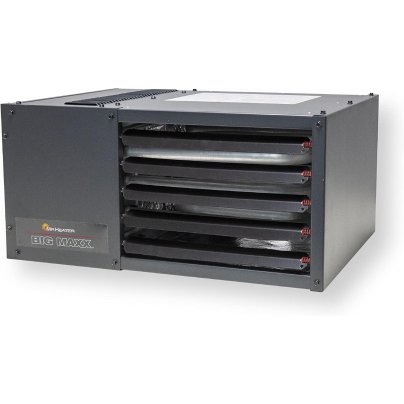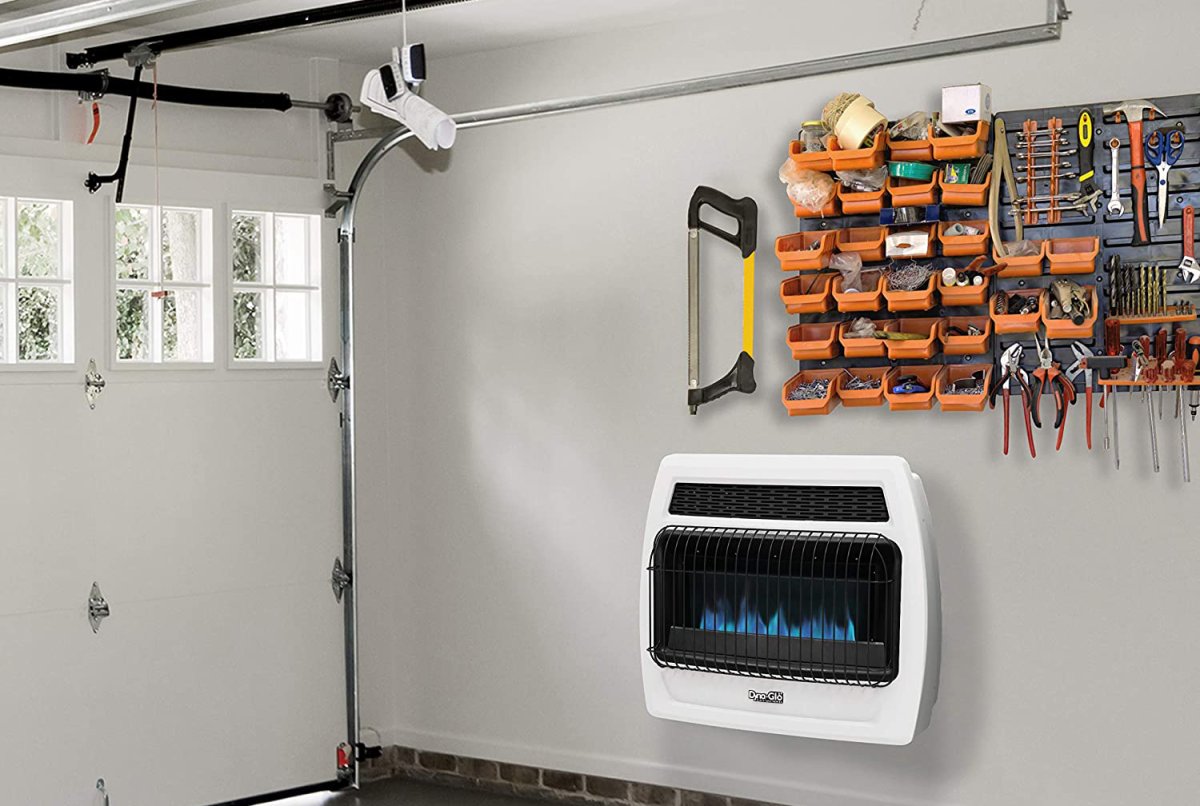
We may earn revenue from the products available on this page and participate in affiliate programs. Learn More ›
Whether you’re passing the colder months with hobbies in your workshop or your must-do repairs simply can’t wait for warmer days, time in a garage space is better when you’re comfortable. When keeping the garage door shut isn’t enough to keep the frigid air out, take the edge off the chill with the best gas garage heater.
These convenient clean-burning gas heaters use natural gas or propane to pump heat into a 1- or 2-car garage space, keeping you, your vehicles, and your tools warm when there’s a temperature drop. This guide will help you choose the best gas garage heater for your shop or garage.
- BEST OVERALL: Mr. Heater 50,000 BTU Big Maxx Natural Gas Heater
- BEST BANG FOR THE BUCK: Mr. Heater Portable Buddy Radiant Propane Heater
- BEST FOR LARGE SPACES: Mr. Heater 80,000 BTU Big Maxx Natural Gas Heater
- BEST FOR SMALL SPACES: Dyna-Glo 10,000 BTU Indoor Natural Gas Heater
- BEST PORTABLE: Mr. Heater 18,000 BTU Big Buddy Portable Heater
- BEST NATURAL GAS: Dyna-Glo 30,000 BTU Natural Gas Vent-Free Wall Heater
- ALSO CONSIDER: Mr. Heater 25,000 BTU Radiant Workshop Heater
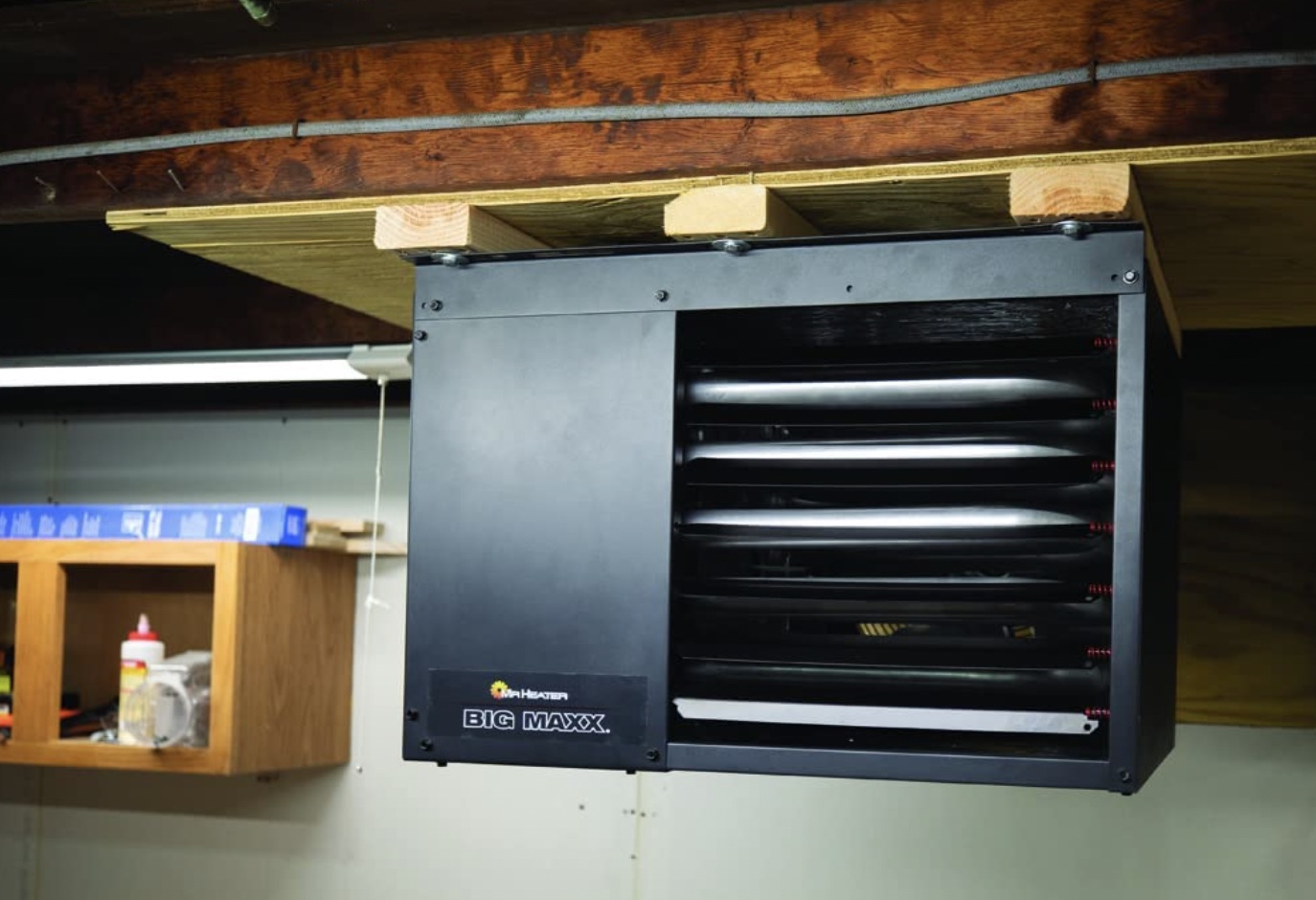
How We Chose the Best Gas Garage Heaters
These recommendations reflect the importance of having steady, reliable heat in cold temperatures from a trusted power source. It’s important to note that some heating methods are not appropriate for small, poorly ventilated spaces, which is why we have both natural gas and propane garage heaters available for specific needs.
Furthermore, we narrowed our search to include the three heating methods: forced air, convection, and radiant (or infrared heater). Each method has a different kind of heat output in the room that some users find more effective than others.
Another primary factor we considered for these recommendations was the total area the unit could capably heat. There are products that work for both large 2-car garages and small work sheds or even campers. Overall, our favorites have cautionary measures in place to ensure safe operation whether they are freestanding gas heaters or mounted on a wall.
Our Top Picks
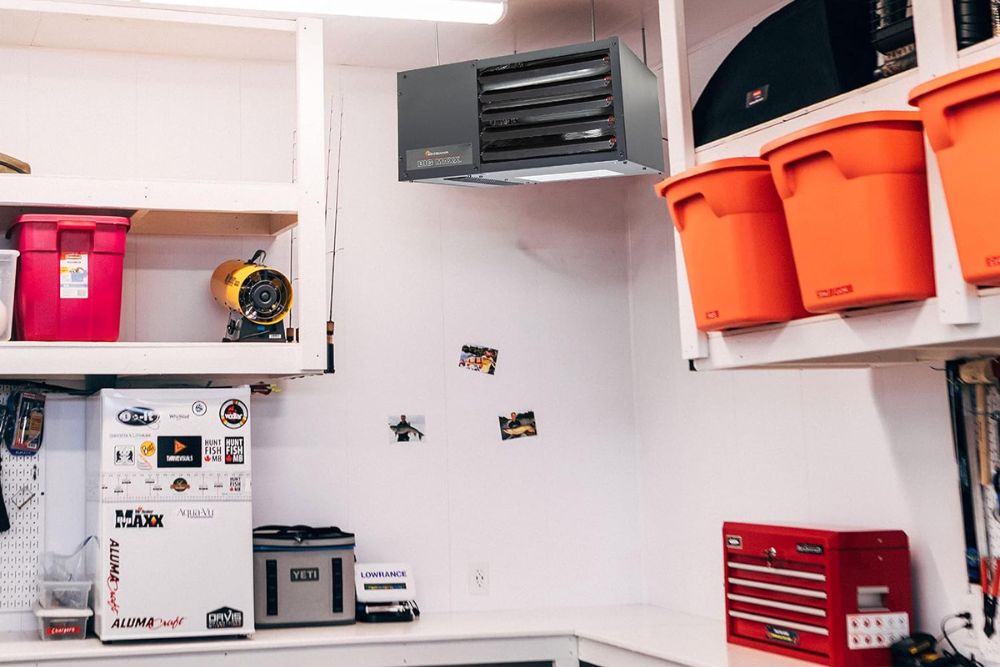
Shopping for the best gas garage heater just got a little easier. The following is a list of some of the best shop space heaters on the market. Be sure to keep the top shopping considerations in mind while comparing these products. From choosing the best fuel source to the proper size, there’s an option for any garage space listed below.
Best Overall
Mr. Heater 50,000 BTU Big Maxx Natural Gas Heater
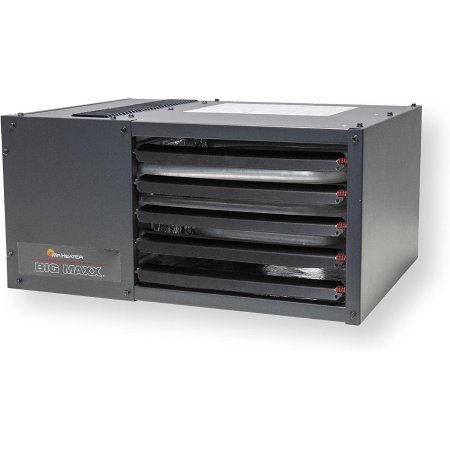
Pros
Cons
Product Specs
- Type: Forced air (vented)
- Fuel source: Natural gas
- BTUs/heating capacity: 50,000 British thermal units (BTUs)
Not all ceiling-mounted units are large and in charge. For medium-size spaces, Mr. Heater’s 50,000 BTU Big Maxx natural gas heater can answer the call. This forced-air heater quickly warms garages and small barns up to 1,667 square feet. The included ceiling brackets make hanging it from the ceiling an easy process.
The accompanying kit also includes the equipment to swap this heater from natural gas to propane, allowing users to decide which fuel source they’d like to use. This unit requires a ventilation kit and a thermostat, both of which are separate purchases.
Get the Mr. Heater 50,000 BTU gas garage heater at Amazon, Tractor Supply Co., or Menards.
Best Bang for the Buck
Mr. Heater Portable Buddy Radiant Propane Heater
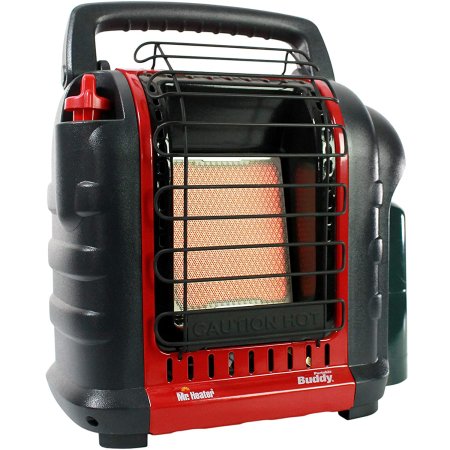
Pros
Cons
Product Specs
- Type: Radiant (infrared/ventless)
- Fuel source: Propane
- BTUs/heating capacity: 4,000 to 9,000 BTUs
Heating a small space doesn’t have to require a big budget. The Portable Buddy from Mr. Heater (model number MH9BX) has the power to heat a small space, the safety features to run safely, and an affordable price tag. This Mr. Heater propane heater accepts small 1-pound bottles of propane, though an adapter hose will hook it to a standard-size propane tank.
Producing 4,000 to 9,000 BTUs, this radiant propane garage heater will warm objects in spaces up to 225 square feet, making it an attractive option for small shops and 1-car garages. Its ventless design means it can be used indoors or out, and the near-100 percent efficiency means it won’t waste precious fuel. This propane garage heater will also shut down if it tips over, the pilot light goes out, or if it detects low-oxygen conditions.
What our tester says: Glenda Taylor, Bob Vila writer and product tester, notes in her
that “for anyone seeking a portable, efficient, and versatile heating solution for a diverse range of indoor and outdoor scenarios, the Mr. Heater Buddy can be a valuable addition. The compact design makes it an excellent recreational or camping heater. This heater is also a dependable emergency heating option for those in regions prone to power outages or extreme weather conditions, providing comfort and safety during unforeseen crises.”
Get the Mr. Heater Portable Buddy gas garage heater at Amazon, Walmart, or Mr.Heater.
Best for Large Spaces
Mr. Heater 80,000 BTU Big Maxx Natural Gas Heater
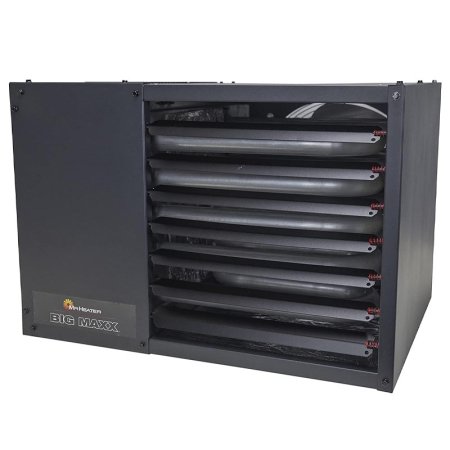
Pros
Cons
Product Specs
- Type: Forced air (ventless)
- Fuel source: Natural gas
- BTUs/heating capacity: 80,000 BTUs
When a small, temporary fix for a large garage or shop won’t cut it, check out the Mr. Heater Big Maxx natural gas heater (model number MHU80). This 80,000 BTU natural gas heater will heat spaces up to 2,667 square feet. The rear-mounted fan draws cold air into the unit, pushes it across a heat exchanger, and then forces it into the space for quick heating.
This model requires 8 feet of clearance under it, so it comes with the necessary brackets for mounting it to the ceiling. It also includes a propane conversion kit, allowing users to swap it over to propane fuel if that’s their preference. While this unit is thermostatically controlled and direct vented, the items necessary to do both are separate purchases.
Get the Mr. Heater 80,000 BTU gas garage heater at Amazon, or Lowe’s.
Best For Small Spaces
Dyna-Glo 10,000 BTU Indoor Natural Gas Heater
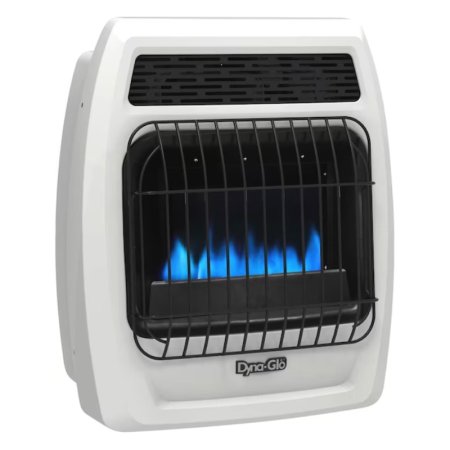
Pros
Cons
Product Specs
- Type: Convection heater
- Fuel source: Natural gas or propane
- BTUs/heating capacity: 10,000 BTU
There’s no need to spend a lot of money on an expensive gas heater for a smaller garage. This gas model from Dyna-Glo will warm smaller spaces at a reasonable price. With its 10,000 BTU heat output, it’s capable of warming up to 300 square feet. This gas heater is also dual fuel: It will work on either propane or natural gas. It’s equipped with a thermostat that automatically adjusts the flame size based on temperature settings.
And since it mounts to the wall, it won’t take up valuable floor space. Its visible blue flame uses convection heat by warming the surrounding air. A thermostat control knob manages the heat output. This model is versatile, too. It’s compatible with an optional blower that can help distribute the air throughout a garage, and it comes with a set of base legs, giving users the option to use it as a stand-alone heater.
Get the Dyna-Glo 10,000 BTU gas garage heater at Lowe’s.
Best Portable
Mr. Heater 18,000 BTU Big Buddy Portable Heater
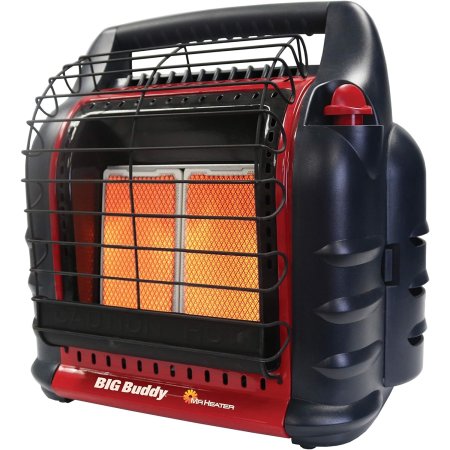
Pros
Cons
Product Specs
- Type: Radiant heater
- Fuel source: Propane gas canisters
- BTUs/heating capacity: 18,000 BTU
With its rugged construction, portable design, and manageable weight, Mr. Heater’s Big Buddy is well suited for heating a garage or an indoor worksite that isn’t climate-controlled. With its 18,000 BTU output, this radiant gas heater can warm spaces up to 450 square feet.
It weighs 17 pounds and has a large handle mounted to the top, making it easy to tote from truck to worksite. It’s also ruggedly made, with a metal grate that protects the heating element and a tough plastic housing. Its dual fuel tanks can last up to 11 hours, making it suitable for long work days in unheated spaces. It also has three heat settings and safety features, including a low oxygen auto shutoff and accidental tip-over shutoff.
Get the Mr. Heater 18,000 BTU gas garage heater at Amazon, Lowe’s, or Walmart.
Best Natural Gas
Dyna-Glo 30,000 BTU Natural Gas Vent-Free Wall Heater
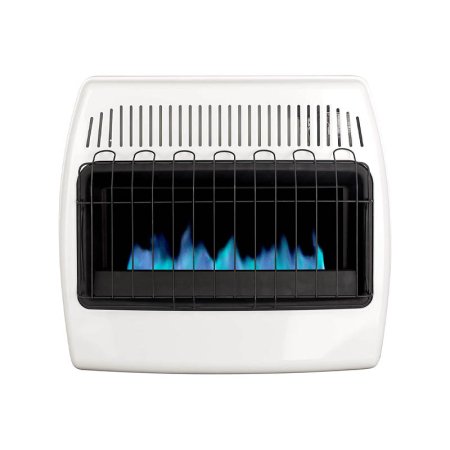
Pros
Cons
Product Specs
- Type: Convection/blue flame (ventless)
- Fuel source: Natural gas
- BTUs/heating capacity: 30,000 BTUs
When it comes to getting the most value from a gas garage heater, Dyna-Glo’s natural gas vent-free wall heater is worth consideration. This 30,000 BTU blue-flame heater will create warm, even convection heat in spaces up to 1,000 square feet. And, since it burns at 99 percent efficiency, this natural gas heater offers an affordable way to stay comfortable.
The vent-free Dyna-Glo heater comes with the hardware required to mount it to the wall. It also has three adjustable heat settings on the top of the unit, allowing users to dial in their ideal temperature. There’s a battery-powered electronic ignition for easy starts and a low-oxygen cutoff switch that shuts down the unit when it detects dangerously low levels of oxygen.
Get the Dyna-Glo 30,000 BTU gas garage heater at Amazon or Tractor Supply Co.
Also Consider
Mr. Heater 25,000 BTU Radiant Workshop Heater
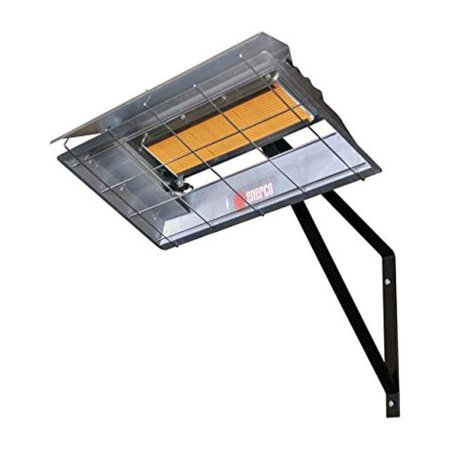
Pros
Cons
Product Specs
- Type: Radiant
- Fuel source: Natural gas
- BTUs/heating capacity: 25,000 BTUs
This gas garage heater stays above the fray by mounting on the wall near the ceiling and casting warm, radiant heat below. With this wall-mount design, it warms the space without taking up valuable garage floor space or potentially coming into contact with people and objects. Its 25,000 BTU output is enough to warm up even larger garages with ease. It also has a low thermostat setting of 35 degrees Fahrenheit, making it a great economical way to keep the garage just above freezing throughout the winter.
It comes equipped with an automatic safety shutoff and a metal grid that protects the heating element.
Get the Mr. Heater 25,000 BTU gas garage heater at Amazon, The Home Depot, or Northern Tool + Equipment.
Jump to Our Top Picks
What to Consider When Choosing a Gas Garage Heater
“Several factors are crucial when selecting the best garage heater,” says Jeff Palla, president of Mr. Handyman, a national home maintenance and repair company. “Consider the size of the space, insulation, and ventilation,” he says. “Look for heaters designed for indoor use to ensure safety. Also, factor in the ease of installation and maintenance, as well as the heater’s efficiency and heating capacity.”
Type
The three main types of gas garage heaters are forced air, convection, and radiant. Here are some more details about the different heating methods used in garage heaters:
- Forced-air gas heaters draw in cold air from the space, heat it, and pump it back in.
- Convection heaters (also known as blue flame) warm the air around them, starting a cycle of warm air rising and cooler air working its way to the heater.
- Radiant heaters project heat onto objects within the space, making them a great option for heating a workbench. Additionally, these heaters come in two variations: direct vent and ventless.
- Direct-vent heaters exhaust their gasses outside, while the exhaust from a ventless heater enters the heated space. Direct-vent heaters are more expensive and more challenging to install, but ventless heaters can irritate those particularly sensitive to odors and fumes.
There are other nonelectric garage heaters as well, such as kerosene-burning options. While all types of heater will help warm a garage, Palla suggests going with radiant heating. “For an unfinished garage, radiant heaters might be more effective as they heat objects directly and work well in drafty or less insulated spaces,” he says “They provide warmth without relying on air circulation.”
Fuel Source
When it comes to choosing a product based on fuel source, note that there are natural gas, electric, and propane gas garage heaters. All are efficient, but there are scenarios where one might be better than another.
“Propane offers portability and can be stored easily, while natural gas tends to be cheaper and is piped directly,” Palla says. “Consider availability, cost, and convenience when choosing between the two.”
For garages that aren’t on natural gas grids, propane heaters might be a better choice. Propane also burns cleanly, but it’s more readily available by the bottle than natural gas. Many gas stations, grocery stores, and home improvement stores operate bottle-swap stations where an empty tank can be exchanged for a full one.
It’s important to understand that propane and natural gas heaters are not interchangeable. The nozzles or jets that supply gas to the flame on each type of heater are differently sized, and users wouldn’t want to use a propane tank, for example, on a natural gas heater without a conversion kit.
Shoppers will want to keep in mind that if they’d prefer not to use fossil fuels, there are electric garage heaters as well. These options can heat small or large garages and are either portable or wall-mounted. Portable electric heaters are lightweight and usually include carrying handles to supply heat wherever needed, while wall-mounted options are semipermanent and easy to install for continuous heat.
Freestanding vs. Mounted
Choosing among the best gas garage heaters might depend on preference between freestanding and mounted units. Users can position freestanding heaters anywhere they’d like, allowing them to focus heat generation in a particular area. This can be a big benefit, particularly when using a smaller heater in a big space.
Mounted units aren’t going anywhere, which has benefits and drawbacks. These units typically install off the ground, keeping them safe and out of the way. As long as they’re large enough to heat an entire space, they’re a very convenient option. If they’re too small, however, there will be cold spots in the garage.
Heating Capacity
Shopping for the best garage heater requires some attention to a unit’s capacity or output. Described in BTUs, a heater’s capacity can help determine the space for which it’s most suitable.
Larger garages and barns will require a large high-output heater with a BTU rating between 80,000 and 100,000. These heaters can often handle garages north of 2,000 square feet in size.
Smaller garages won’t need as much firepower. For an attached 1- or 2-car garage, a 30,000 BTU unit is often more than suitable. Very localized heat, such as above a workbench, might only require 5,000 BTUs.
“Calculate the BTUs needed by multiplying the garage’s square footage by the heating factor,” says Palla. “Generally, for moderately warmer climates, allocate around 30 to 35 BTUs per square foot. In colder regions, aim for 45 to 50 BTUs per square foot to effectively heat the space.”
Safety
The best gas garage heaters are clean burning, efficient, and easy to use, but they aren’t without safety concerns. The potential for accidents and injuries certainly increases with a gas heater installed in a garage.
To help reduce the risk of accidents, many of the best gas garage heaters have safety features, such as child-safety locks, that make it difficult for a child to light a heater inadvertently. Also, low-oxygen shutoffs will detect when effective, safe combustion isn’t possible, shutting the heater off entirely.
It’s also extremely important to ensure that carbon monoxide detectors within the home and garage are working properly. Gas heaters that are well maintained and running properly create an “ideal burn,” which poses no threat of carbon monoxide poisoning.
But, poorly running heaters don’t burn as efficiently and can cause unsafe carbon monoxide buildup. A carbon monoxide detector will alert when dangerous levels of carbon monoxide are building up within the home or garage, which can be the result of many different factors. Since carbon monoxide is colorless and odorless, these detectors are sometimes the only way to tell that there is an issue.
Finally, keeping flammable items clear of a heater is essential. Garage spaces are full of flammable items, combustible liquids, and other dangerous materials that can cause a fire if they’re in close proximity to a gas heater.
Installation
How simple or challenging a particular gas garage heater might be to install could be a factor while shopping. Folks looking to unbox a heater and warm up the space right away might prefer a portable heater that simply screws onto a propane tank. Those looking for a more permanent solution might prefer a mounted unit, which will require a more involved installation process.
Installing mounted units often requires specialized brackets that attach to the ceiling or wall. Also, if these units vent outside, they require a hole in the wall for the exhaust pipe to run through. If connecting to gas pipes is necessary, it might be best to hire out the process to a plumber.
Additional Features
Depending on the style, the best gas garage heaters have convenient features to make them more useful or simply easier to use.
Mounted units compatible with external thermostats make controlling garage temperatures much easier. Setting the thermostat to a preferred temperature will ensure the heater kicks on and off, maintaining that temperature within the space. Also, remote controls make adjusting temperatures an easier process.
For portable units, temperature-control knobs allow users to throttle the flame output to balance warmth and fuel efficiency, stretching a bottle of propane as far as possible.
FAQs
Even though you’re familiar with the best gas garage heaters on the market, you might still have some questions about these heaters. Below is a collection of some of the most commonly asked questions about gas garage heaters along with the answers to clear them up.
Q. Are gas garage heaters safe to use?
As long as you follow the manufacturer’s instructions for use and installation, gas garage heaters are safe. Just be sure to vent units that require it and ensure that the carbon monoxide detectors are working.
Q. Can I heat my garage with a propane heater?
Yes, there are many propane-fueled heaters available that will heat a garage safely and efficiently.
Q. Do you need ventilation when using a propane heater?
Depending on the particular product, some propane heaters do need ventilation while others do not. It’s helpful to check the manufacturer’s use and installation instructions.
Q. How big of a heater do I need for a 2-car garage?
The answer to this question depends on the region in which you live. If you experience very mild winters, you might require only 30 BTUs per square foot, while very cold climates will be double that.
A 500-square-foot garage in a warmer climate may only require 15,000 BTUs, while that same garage in colder climates could require 30,000 BTUs. Those numbers can jump considerably if the space is poorly insulated.
Q. How long does a gas garage heater last?
Gas appliances, particularly furnaces and heaters, have an average life expectancy between 15 and 20 years. Keep in mind that factors such as regular servicing or humidity levels will have an effect on how long a heater lasts.
